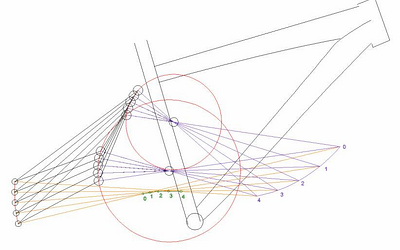
Figure 4.7)
Click to enlarge
Figure 4.7) shows the paths for the rear axle, IC, and center of curvature, as well as the lines perpendicular to the rear axle path for the Rocky Mountain ETS-X70.
There is a fairly well defined virtual pivot located well above and behind the bottom bracket. The height is similar to that of the NRS, but farther forward. This will give the bike characteristics similar to that of a very high pivot mono-pivot; though the virtual pivot is located a bit farther back then could be the case on a standard mono-pivot. One should find quite a bit of both anti-squat and kickback with this frame, though the tradeoff will be a tad less then in conventional mono-pivots. Shock absorption should be good, in spite of the relatively tight wheel path curvature, due to the high virtual pivot and rearward sloping wheel path through travel.
Having the links located above the chain line is a nice feature, however, this does raise concerns regarding lateral stiffness. Preliminary observations for frame flex, taken by pressing laterally on a pedal located at six o'clock, seem to indicate that the bike has lateral stiffness on par with typical XC dualies. The author has done some accelerations on this bike and found that the frame has adequate stiffness with regard to pedaling. Perhaps a greater concern, however, is high-speed cornering, above say 25 to 30 mph. To date, we have no observations on how the frame reacts under these conditions.
This is a very unique frame design, which will probably prove well suited for some, but not for others. As always, we say that test rides should always be taken.